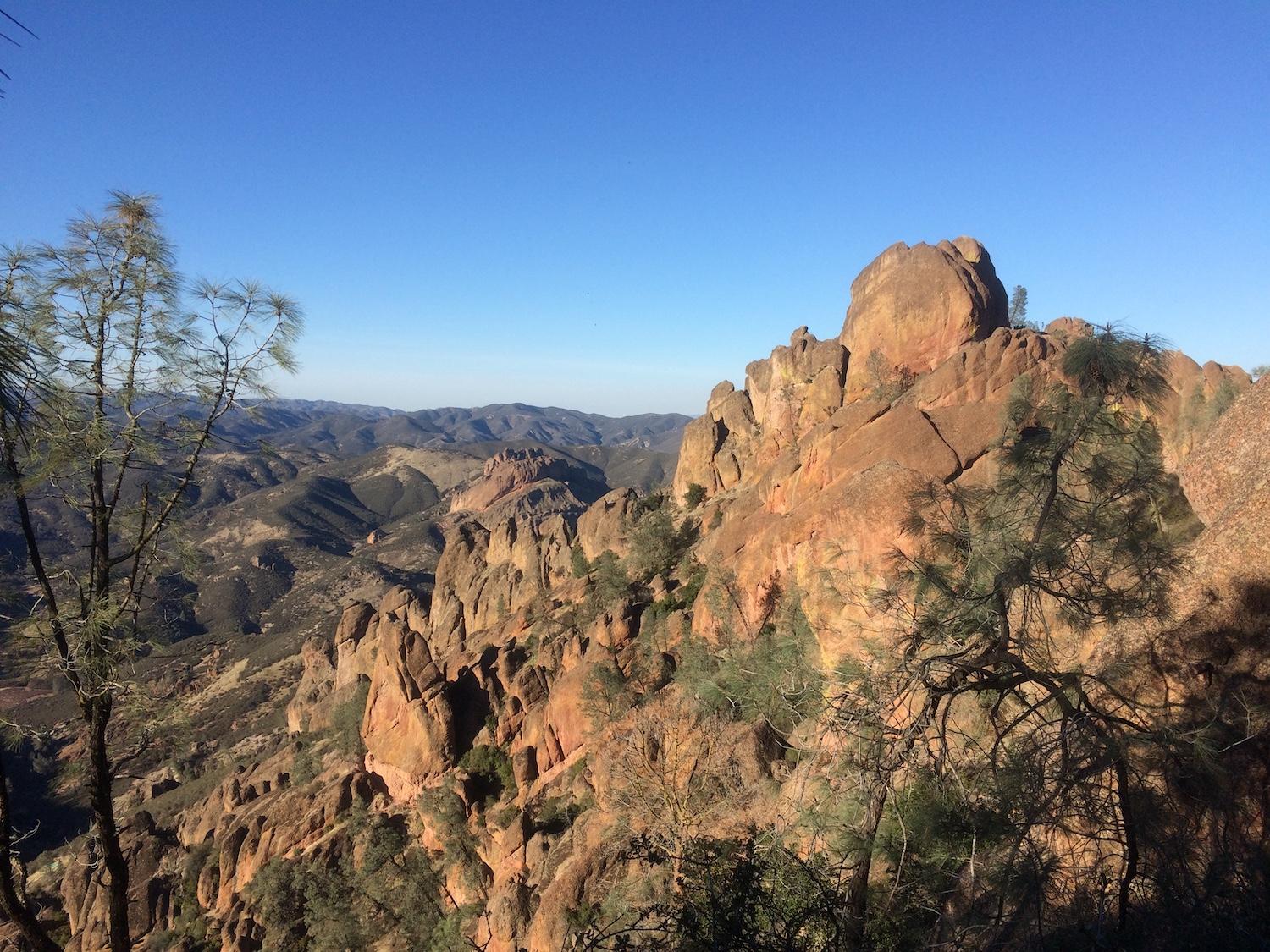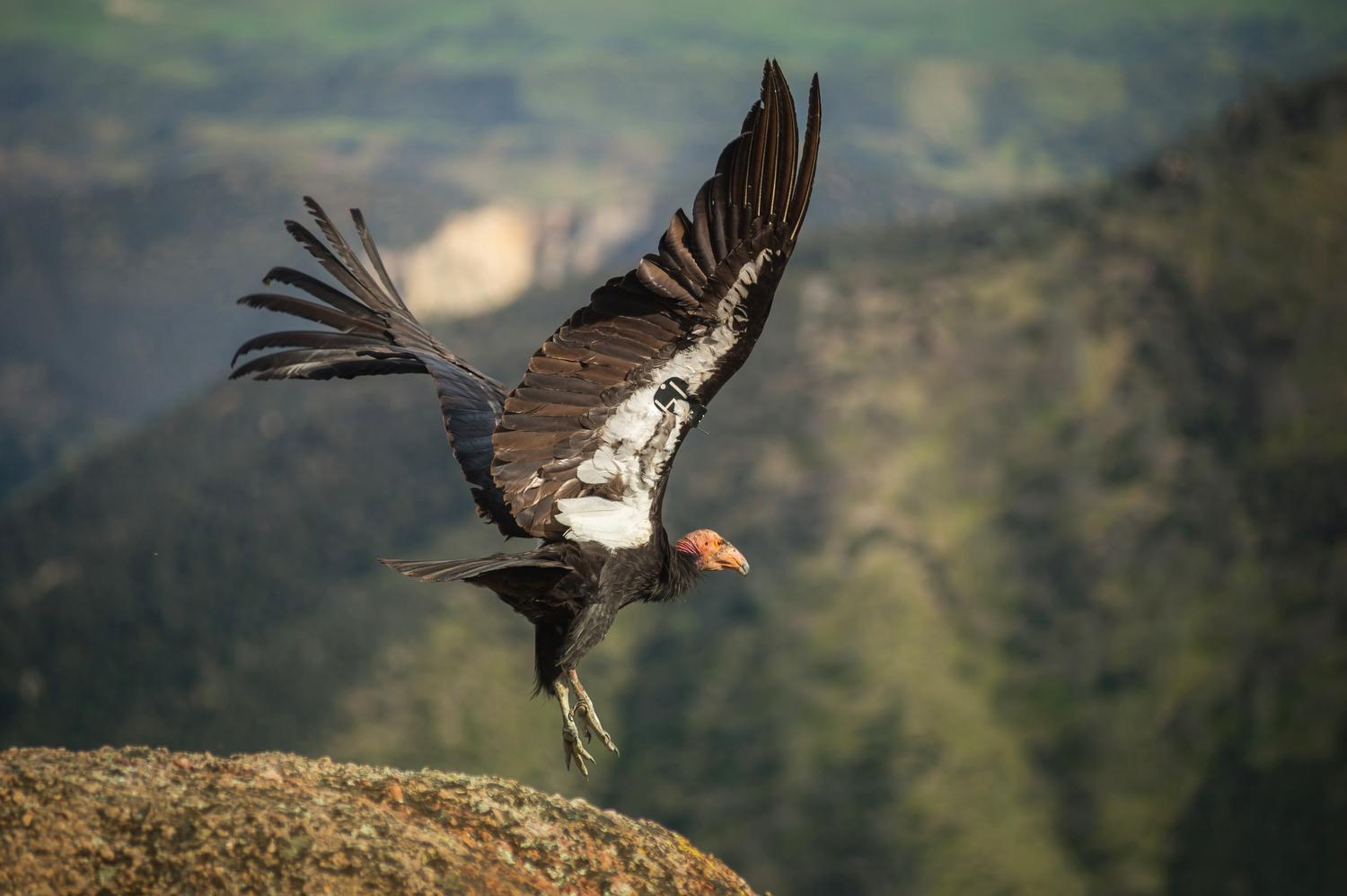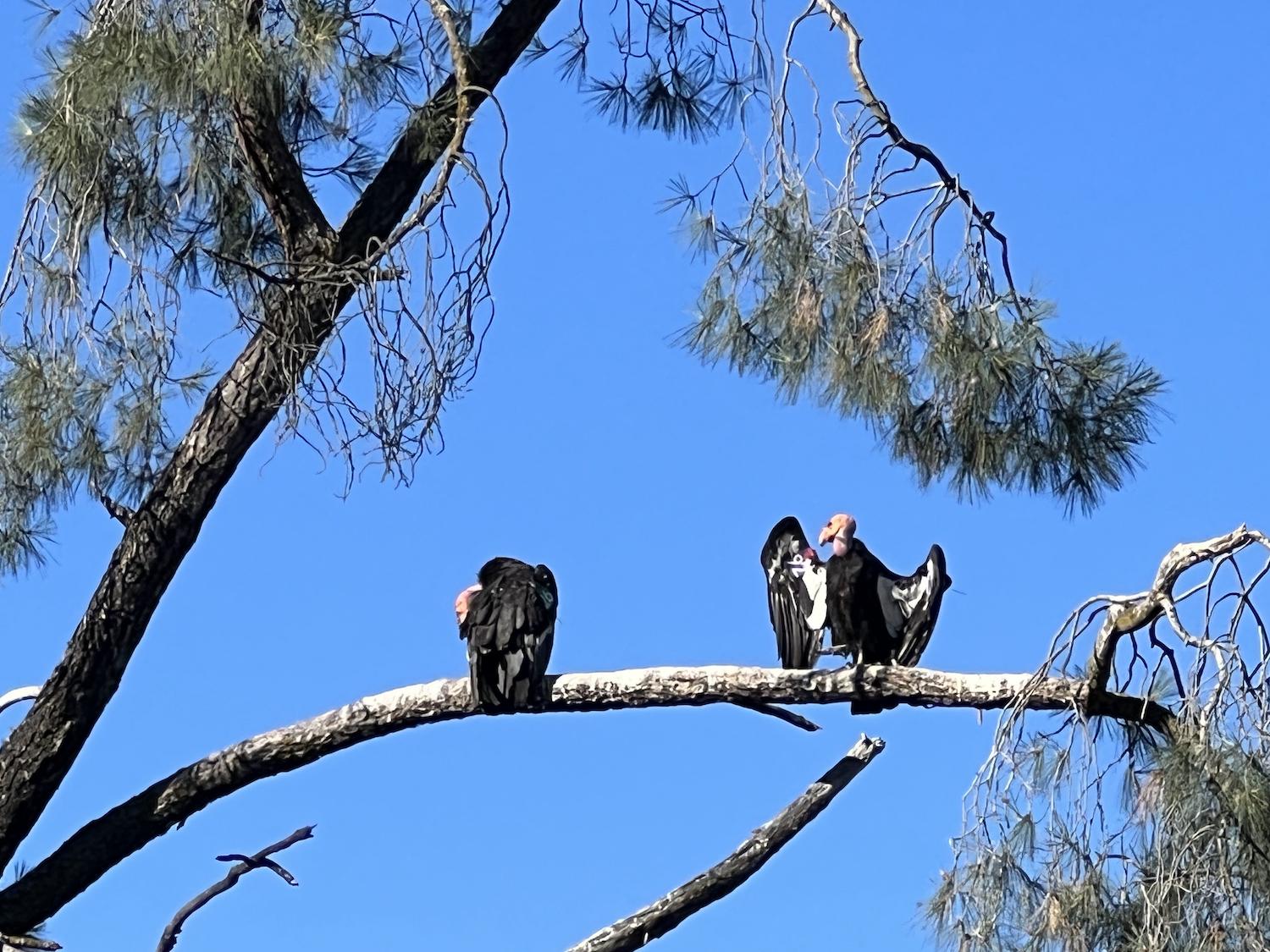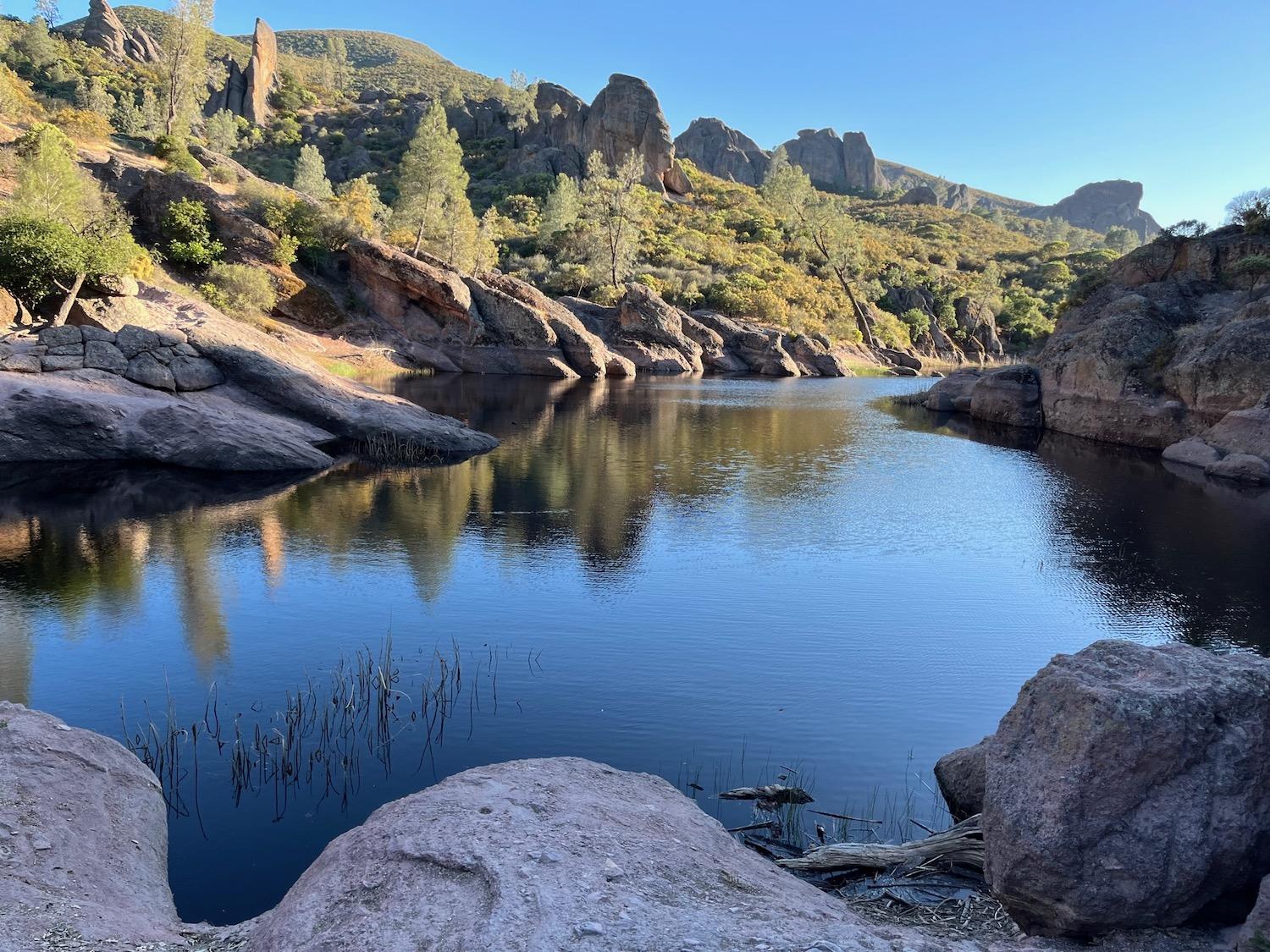
Searching For Condors At Pinnacles National Park
By Lori Sonken
PAICINES, Calif. — When I hiked at Grand Canyon National Park in January, I never spotted a California condor, but Pinnacles National Park, the first national park where the birds bred in captivity were released into the wild, raised my hopes again of seeing these magnificent birds. Even if I missed them, I could wander the 30 miles of trails through rolling hills and chaparral past steep rocky outcroppings and into caves.
Located about two hours southeast of San Francisco, the park’s caves and gigantic boulders formed by magma bubbling up from an ancient volcano millions of years ago provide habitat for the bird listed as endangered in 1967 due to lead poisoning, DDT contamination, collisions with utility wires and other human-caused factors.
Early this year there were 347 California condors flying over North America, said Alacia Welch, the park’s condor program manager, in an email. Avian flu has killed birds in Utah and Arizona this year, but has not reached the 88 condors soaring over central California.

California condors raised in captivity are released into the wild at Pinnacles National Park/NPS
Traveling with my friend Val, we followed instructions given by the park's condor crew leader Katharine “Rose” Fielding.
“The High Peaks trail will be your best shot for seeing condors in the park. It's a 5-mile loop with lots of elevation gain and steep sections, so you'll definitely want to be prepared with lots of water and get an early start,” she told us in an email.
Coping With The Locals
We had intended on spending the night before our hike in the campground. While the tent Val had borrowed was missing poles, we didn't think it would be a problem. Nighttime lows temperatures are in the 50s. We would enjoy the park’s commitment to becoming a certified Dark Sky Park.
Among Pinnacles other residents are raccoons, which have gotten used to raiding campsites for food. As we were sitting down to dinner, one of the masked invaders actually climbed onto the picnic table hoping to steal a meal. Fortunately, our food was covered and the raccoon didn’t get a bite, but it really underscored why the campground provides metal food containers and warns visitors that raccoons can open coolers, climb into open car windows, and tear tents to get at food.
“They’ll even work in teams, with one raccoon distracting you while another grabs your food," said a sign posted on the picnic table. It’s best to keep food in a food storage locker available at campsites or in a closed vehicle.
Not desiring to sleep without tents in raccoon habitat, we gathered up our belongings and headed to a hotel in Hollister about 45 minutes away.

Condors perched high overhead in the trees, oblivious to us/Valerie Lapin
After a short night’s sleep, we were on the Condor Gulch-High Peaks Trail by 6:30 a.m. the next day. The temperature was in the 60s and rising fog could be seen in the distance. About an hour into our hike, I noticed what looked like a lost backpack on the trail. I was about to pick it up when I spotted a young man standing off trail. He held one index finger in front of his lips and the other pointed to a 60-foot-high gray pine tree.
Even without binoculars, it was easy to see two California condors on a branch. One of the largest birds in North America, they weigh about 20 pounds each. They sat still, not displaying their wings that can span 9.5 feet.
With binoculars, we saw they were tagged numbers 92 and 26. A smaller bird without tags rested on a higher branch,
Thrilled to see three of the less than 350 California condors flying free in North American, I was grateful to those responsible for keeping the species alive. We watched them for close to an hour. Dozens of hikers passed beneath the birds oblivious to passersby. Occasionally the birds moved a little or stretched a wing, but for the most part they perched still while awakening.
Determined to be off the trail before temperatures soared into the 90s, we left the trail by 10:30 a.m., never seeing the birds soar at speeds up to 55 mph or dive for their carrion breakfast.
A Microcosm
The condor recovery plan aims to establish two wild, geographically distinct, self-sustaining populations — one in California and one in Arizona — with 150 birds in the wild and at least 15 breeding pairs, plus a third population in captivity, according to the US Fish and Wildlife Service.
Aside from seeing California condors, visitors to Pinnacles National Park might find deer, turkey, fox or if they’re especially fortunate a bobcat. Oh, and raccoons.
“One thing I love about Pinnacles is it’s a microcosm of so many other parks," said Ranger Rich Moorer, referring to the varying experiences you can enjoy in the park.

Bear Gulch Reservoir/Lori Sonken
Friends of Pinnacles calls the park, of which roughly 65 percent of its 26,500 acres are officially designated wilderness, “a geologist’s playground peppered with silica-rich rhyolite, layered lava flow bands and perlite pockets of green volcanic glass.”
Seasoned climbers shimmy up challenging volcanic breccia and tuff rocks that are significantly weaker than the more common granite and basalt. Only well-trained climbers are advised to attempt the rocks; fatalities have occurred, including Joseph Kraut, a physician who died from a fall in 2014.
There are caves to explore at Bear Gulch and Balconies. But both lower and upper caves at Bear Gulch are closed during bat pupping season from early May-mid July. Near Bear Gulch Cave the Bear Gulch Reservoir, surrounded by rock formations, provides habitat for the threatened red-legged frog. The dam was built in 1935 by the Civilian Conservation Corps to prevent flooding downstream and for its aesthetics.
About 500 species of bees — the highest concentration nationwide — call the oaks and chapparal habitat at Pinnacles home. Acorn woodpeckers bore multiple holes in tree stumps, for food storage. A variety of lichen color the rocks in green, red, yellow, and other hues.

Acorn woodpeckers leave a trail of their activity in trees/Lori Sonken
Pinnacles has several unique, albeit unnatural, features, too. The park has a popular outdoor swimming pool adjacent to the campground. The pool accompanied land acquired with the 134-space campground in 2005. The campground has showers and a camp store with WiFi.
The park also once had a large population of feral pigs, which prompted installation of a fence.
“Pinnacles has the distinction of having the largest pig-free area enclosed in a fence on the U.S. mainland," said Paul Johnson, wildlife biologist at the park, in an email.
The woven-wire mesh fence keeps out feral pigs known to tear up the habitat, but allows the ground squirrel, desert cottontail, brush rabbit, and gray fox to clamber through holes in the fence. Coyotes, mountain lions, and all but the youngest deer can jump over it, Johnson said.
“I was really impressed as a city dweller with the amount of wildlife at Pinnacles,” said Moorer. He came to Pinnacles from the National Capital Parks region in the Washington, D.C. area at the end of 2020. Like most full-time staff at Pinnacles, Moorer lives in Hollister. It takes him about 45 minutes to commute to work “if you don’t get stuck behind a cattle truck or a slow-moving vehicle,” he said,
Hollister is also where CAL fire is located, important for dousing fires that frequent the fire-prone park.
“Over the last 100 years, it is likely that 100 percent of the park has burned,” Moorer said.
The last fire was in August 2021. Reported at 4:30 p.m., the park benefitted from air support arriving an hour later.
Least Visited?
This year the park had “an uptick of wildflowers this year because of all the rain,” Moorer said, and that helped boost visitation. There were 56,000 visitors in April, a statistic approaching the busiest month on record at 58,000 visitors.
In 2021, there were 348,857 visitors to the park.
“Just because we sometimes show up on the list of ‘least visited’ parks does not mean we are not busy,” Moorer said.
The park can seem like an urban park, even though it’s located in a rural area. By this Moorer means the park is busiest on weekends and holidays. He advises visitors to arrive before 9 a.m. to beat the crowds. Because parking is limited, the park offers shuttle buses in the spring when visitation is especially high.
There are two entrances — the east entrance where the campground is located is in Paicines. Soledad, a city in Monterey County with restaurants and a population about 25,000, is closest to the west entrance. Rather than make the 1.5-hour drive from one side to the other — it’s not possible to pass through the park by vehicle — visitors generally stick with one side and are advised to bring containers with water, as there is no treated water available on the trails.
“People get into trouble when they go by themselves without enough water," said Moorer.
Since Moorer arrived at the park, there have been 4-5 fatalities, including one person succumbing to heat exhaustion. Daytime temperatures can creep above 100° F in July and August and dip below freezing during the winter. The weather is most pleasant during the spring and fall, according to the park’s website.
Pinnacles National Monument was established by President Theodore Roosevelt in 1908. In 2013, the monument was redesignated as a national park.

Add comment